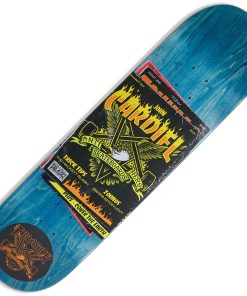Colonialism Louis Digital Reissue Deck (White) (8.5″) Colonialism
$ 90,00 $ 45,00
Colonialism Louis Digital Reissue Deck (White) (8.75). Stain Colour may vary. Grip not included.
Imported.
A quick glance at the re-issue of the fifth graphic from Colonialism reveals what you would think was the album cover for Bobby Digital in Stereo (1998), the solo hip-hop debut from RZA of the legendary Wu-Tang Clan. However, after a closer look, it becomes evident that the graphic pays homage not only to this classic album (a favorite of ours at the company) but also one of the most important events to take place in Western Canadian history: The North West Resistance of 1885.
The North West Resistance – often, but mistakably, referred to as a “rebellion” – was an uprising by the Métis people, along with an associated uprising by First Nations, Cree and Assiniboine peoples, against the federal government in what was, during the spring of 1885, the District of Saskatchewan (present day Saskatchewan and Alberta). The resistance took place against the backdrop of Western colonization and development on the Canadian prairies during the latter part of the 19th century. While Ottawa had already encroached on First Nations peoples’ lands, signed Treaties with First Nations people, settled descendants from Europe, and extended the Canadian Pacific Railway through the prairies, direct political representation from Ottawa was absent in the territory. A sense of alienation and neglect from the federal government was felt among all residents, including First Nations peoples, settlers, and the Métis people.
The plains bison, which had been the means of subsistence for First Nations peoples for generations, were disappearing. The Treaties First Nations peoples had entered into were being dishonoured, and starvation and disease had become endemic on reserves. The Métis people were not confined to reserves but they had their own set of challenges. While they too had depended on the bison for food and livelihood, their old life as fur traders was fading away. Perhaps more importantly, surveyors, sent on behalf of the federal government, were arriving to subdivide and sell off the lands to which the Métis people were entitled. As their rights to land were increasingly ignored, the Métis people feared dispossession was again on the horizon. White settlers in the region were also upset as they waited on their property titles, which were necessary for them to receive loans and improve their farms. The sentiment of frustration led all parties to hold meetings and eventually recruit Louis Riel, a Métis politician (pictured at the centre of the graphic), from the United States, where he had been living in exile after leading the earlier 1869-1870 Red River uprising.
In the summer of 1884, Riel returned to unite those dissatisfied in the North West and by winter, appealed to the government of Prime Minister Sir John A. MacDonald, who had remained indifferent to the plight of people on the prairies. Riel initially attempted to capture Ottawa’s attention with a petition outlining their grievances but achieved little success. In 1885, Riel and some others established the Provisional Government of Saskatchewan, seized the Roman Catholic church at the Métis settlement of Batoche, and demanded that the Hudson Bay Company forfeit its trading post at Fort Carlton. It was not long before armed conflict broke out between Riel and members of the North West Mounted Police at Duck Lake (between Batoche and Fort Carlton), inspiring other acts of resistance in the territory thereafter.
The turmoil between Riel’s followers and local forces finally captured the attention of the federal government. MacDonald mobilized troops and transported them by rail to Batoche, where they would eventually suppress the Métis peoples and arrest Riel. Riel was then charged with high treason based on the interpretation of British law; the British Treason Act carried the death penalty, whereas the treason law in Canada did not. MacDonald also had the trial moved to Regina from Winnipeg after discovering that a Manitoba jury could be half Métis. The trial, which lasted only five days, resulted in a guilty verdict. Despite various political appeals, Riel was hung in Regina on November 16th, 1885. While Riel was undoubtedly a controversial figure throughout history, he is commemorated for the role he played in defending the French language and the rights of Métis and First Nations peoples in Canada.
Michael Langan is an Indigenous artist from Cote First Nation, Treaty 4 Territory, who is committed to educating people through creative renderings of our colonial past. After moving to Regina almost 20 years ago, Micheal immersed himself in the local skateboard community, of which he has remained a prominent member ever since. Last spring, Micheal launched his own skateboard company – Colonialism Skateboards – to draw attention to, and have people engage with, complex and untelling aspects of Indigenous Canadian history and culture. By combining skateboard art with a history lesson on Indigenous culture and colonialism in Canada, Micheal’s innovative approach is leading a conversation about how Canadians, especially youth, can move forward together through reconciliation.
Profoundly influenced by his upbringing and experiences as an inter-generational residential school survivor, Micheal’s initiative has grown and expanded beyond the realm of skateboarding. He has been invited to elementary and high school classrooms in Regina, Fort Qu’Appelle, as well as various community panels to speak about his company and its mandate. He was recently invited to the Winnipeg Art Gallery to speak on an Indigenous artist panel, where his boards were featured.
Colonialism Skateboards continues to receive international attention as Micheal inspires skateboarders and non-skateboarders alike to learn about the history and enduring legacy of colonization, and to think about ways to address these ongoing challenges locally and globally.
Colonialism has produced several pro boards for Joe Buffalo as well as a guest board with Dustin Henry.
Micheal has been a long time member of the Tiki Room family.
Fast Shipping and Professional Packaging
We have a range of shipping options thanks to our long-term relationship with UPS FedEx DHL. Our warehouse staff is highly skilled and will wrap your goods in accordance with our exact and precise specifications. Your goods will undergo a thorough examination and will be properly packaged prior to being delivered. We ship to thousands of customers every day from all over the world. This is a sign of our determination to be the largest online retailer in the world. The warehouses and centers for distribution are in Europe, as well as the USA.
Orders that include more than 1 item are assigned processing times in accordance with the item.
We will carefully examine all items ordered before shipping. Most orders are shipped within 48 hours. The estimated delivery time is between 3 and 7 days.
Returns
We do not manage the stock in our factory and warehouse. The actual levels of stock can change at any time. Please be aware that it's possible that your order will run out of stock even after you have placed the order.
Our policy lasts thirty days. If 30 days have passed by since your purchase however, we're unable to give you a return or exchange.
Your item must be in the original packaging and in good condition. It must also not be used. You must have the item in its original packaging.











































